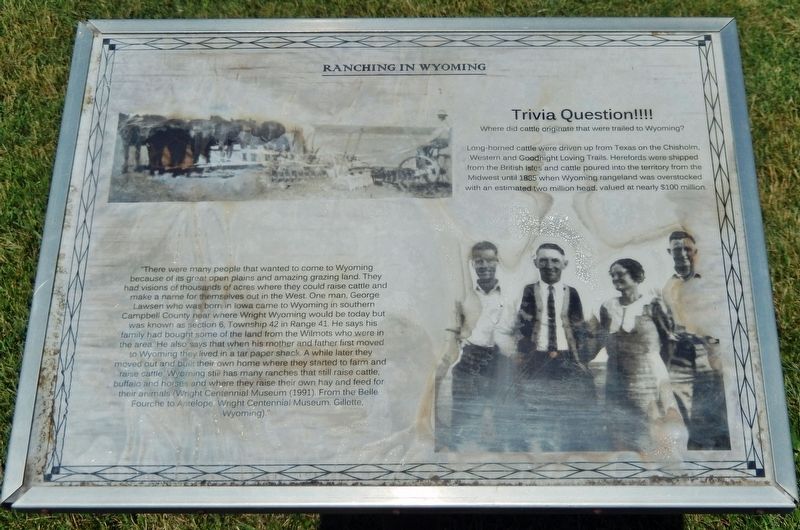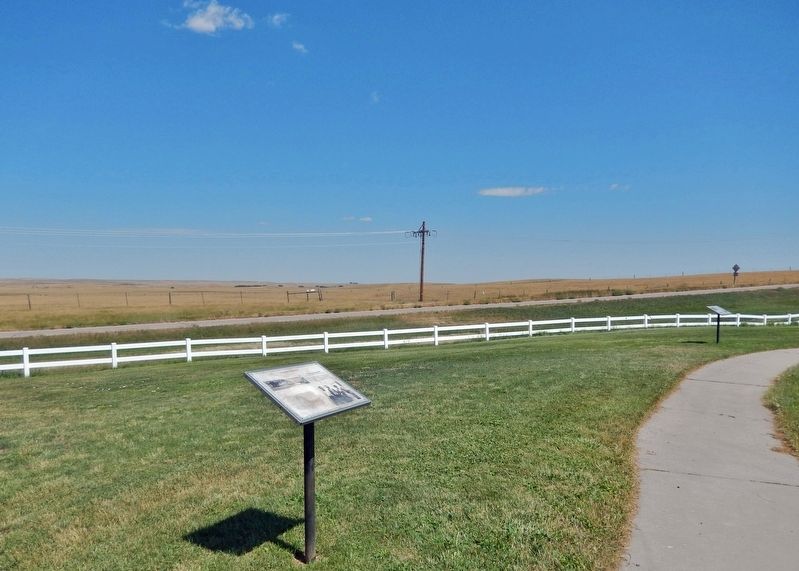Wright in Campbell County, Wyoming — The American West (Mountains)
Ranching in Wyoming
Where did cattle originate that were trailed to Wyoming?
Long-horned cattle were driven up from Texas on the Chisholm, Western and Goodnight Loving Trails. Herefords were shipped from the British Isles and cattle poured into the territory from the Midwest until 1885 when Wyoming rangeland was overstocked with an estimated two million head, valued at nearly $100 million.
"There were many people that wanted to come to Wyoming because of its great open plains and amazing grazing land. They had visions of thousands of acres where they could raise cattle and make a name for themselves out in the West. One man, George Lawsen who was born in Iowa came to Wyoming in southern Campbell County near where Wright Wyoming would be today but was known as section 6, Township 42 in Range 41. He says his family had bought some of the land from the Wilmots who were in the area. He also says that when his mother and father first moved to Wyoming they lived in a tar paper shack. A while later they moved out and built their own home where they started to farm and raise cattle. Wyoming still has many ranches that still raise cattle, buffalo and horses and where they raise their own hay and feed for their animals (Wright Centennial Museum (1991). From the Belle Fourche to Antelope, Wright Centennial Museum, Gillette, Wyoming)."
Topics. This historical marker is listed in these topic lists: Agriculture • Animals • Industry & Commerce • Settlements & Settlers. A significant historical year for this entry is 1885.
Location. 43° 45.782′ N, 105° 28.934′ W. Marker is in Wright, Wyoming, in Campbell County. Marker can be reached from the intersection of State Highway 387 and Ranch Drive, on the right when traveling west. Marker is located on the Wright Visitor Center & Centennial Museum grounds. Touch for map. Marker is at or near this postal address: 15089 Wyoming Highway 387, Wright WY 82732, United States of America. Touch for directions.
Other nearby markers. At least 7 other markers are within walking distance of this marker. The Beginning of Wright, a Company Town (within shouting distance of this marker); Tertiary (Paleogene) Period (about 300 feet away, measured in a direct line); The Building of Wright, Wyoming (about 300 feet away); Veterans Memorial (about 300 feet away); The Beginning of Coal Mining in Wyoming (about 400 feet away); Underground Mining with Children (about 400 feet away); Lectra Haul Unit Rig (approx. 0.2 miles away).
Also see . . . The Wyoming Cattle Boom, 1868-1886 (WyoHistory.org). Excerpt:
Between 1840 and 1870 a series of events combined to bring an inevitable surge of livestock to the northern plains. University of Wyoming historian Phil Roberts estimates that between 1841 and 1860, roughly 350,000 people “crossed what is now Wyoming.” As early as 1836, pioneers and freighters drove wagons over the Oregon Trail to Idaho. Mormons began passing through Wyoming on their way to Utah. A gold discovery outside Sutter’s Mill in California in 1848 vastly increased the traffic. At the same time, railroads began to revolutionize beef transport—both for live cattle and chilled, butchered beef. In 1851, the Missouri Pacific Railroad laid down the first tracks west of the Mississippi. Then there was the Civil War. This epic conflict left two enduring changes in the American cattle business: centralization of the beef-packing industry and a huge surplus (around five million) of Longhorn cattle in Texas.(Submitted on March 14, 2024, by Cosmos Mariner of Cape Canaveral, Florida.)
Credits. This page was last revised on March 14, 2024. It was originally submitted on March 14, 2024, by Cosmos Mariner of Cape Canaveral, Florida. This page has been viewed 45 times since then. Photos: 1, 2. submitted on March 14, 2024, by Cosmos Mariner of Cape Canaveral, Florida.

